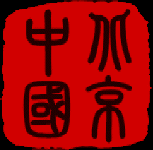 |
Forbidden City |
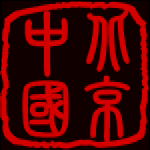 |
 |
Forbidden City |
 |
Layout of the Forbidden City
|
The Legend of the
WatchTowers
|
The Great Wall of China had a vital link to the Forbidden City. The Great Wall was constructed with watchtowers all along its structure. It was from these watchtowers that smoke signals could be sent as a way of communicating with the Forbidden City.
中国的长城对于紫禁城来说是一个很重要的环节。沿着长城也建有瞭望塔。通过这些瞭望塔可以发布烟雾信号,作为于皇宫沟通的一个途径。
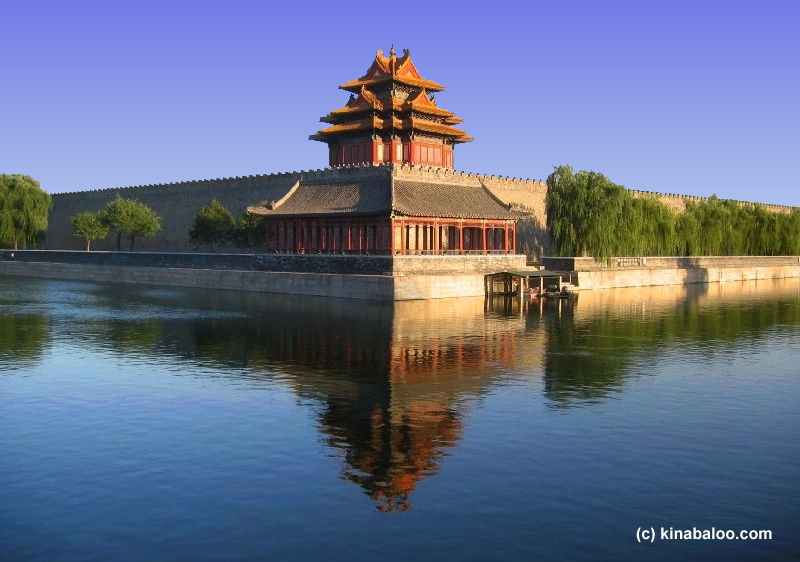
The Forbidden City can be divided into two parts.
The southern section, the 'Outer Court', consists of five halls used for ceremonial purposes and other official business. These include the magnificant Hall of Supreme Harmony. The northern section, the 'Inner Court', was where the emperor worked and lived with his family, eunuchs and maid-servants.
The Outer Court consists of large structures and enormous spaces. The first part of the Inner Court is a series of three halls that are a smaller mirror of the main three in the Outer Court, and then a grander version of the ancient hutong style of alleys and courtyards that serve as living quarters.
紫禁城可以分成两部分。
南半部是外朝,有三个大殿两个门,包括宏伟的太和殿,这里是皇上举行典礼和朝会的地方。北半部为“内朝”,是皇上工作生活的地方,和他的家人、太监、宫女们。
外朝由三个宏伟的大殿和巨大的空间组成。内朝的第一部分是三个排成一排的宫殿,和外朝的主殿一样但稍小点,然后是宏伟版本的胡同式建筑,和小路、院子组成居住的地方。
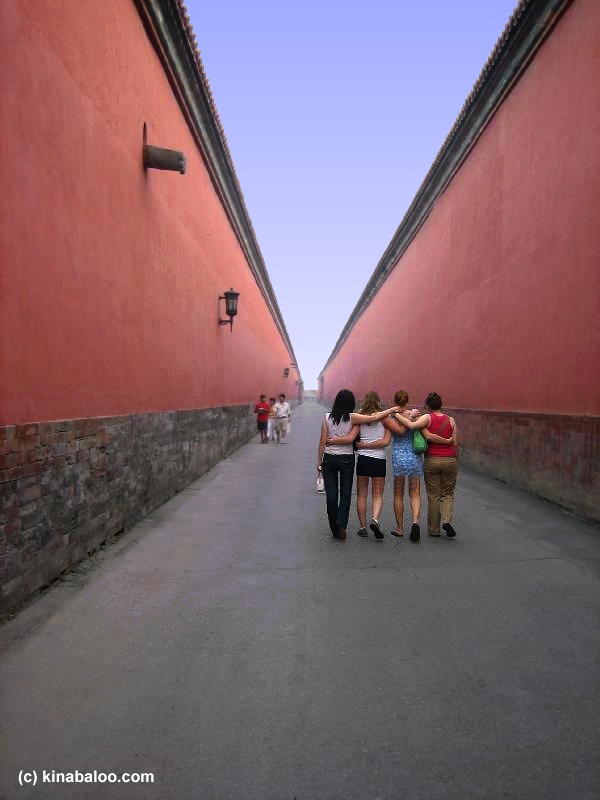
Between the Outer and Inner Courts, and between the courtyards of the Inner Court, are many high-walled alleys. The visitor can easily feel that they are in a maze! Some of the alleys are very long.
在外朝和内朝之间,在内朝的庭院与庭院之间有许多,两边有着高墙的小路。游客们轻易的就能感觉到像在迷宫里,有的小路是非常长的。
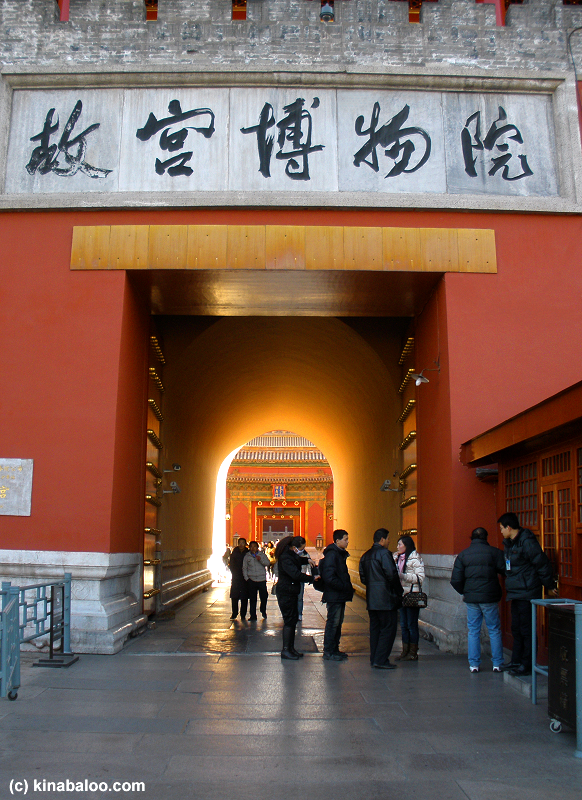
Because golden yellow had long been a symbol of the royal family and it is a dominant color in the Forbidden City. Roofs are constructed with yellow glazed tiles; decorations in the palace are often yellow; even the paving bricks on the floors of the halls are made a bit yellow by a special process.
In the ancient chinese theory of the Five Elements, each had an associated color. To the ancient Chinese, yellow represents earth - and the Earth, which for a long time was considered the center of the universe by our ancestors. Pictorially, yellow was placed in the middle of the five elements, to indicate that the earth is central and respected.
Later, this notion, combined with the idea of the great unification of Confucianism, bolstered the view that the united royal family, with the Han nationality as its main body, was an empire in the position of central earth, different from the surrounding foreign countries. Thus, yellow was associated with homage through connection to earth, providing a rational reasoning for the emperor's legitimacy and rule.
The imperial robes were also made in the traditional golden yellow - and also have images of the dragon on them. The use of yellow (and red/purple) and the dragon to distinguish the emperor from other mortals harks back to Legalism, a movement that sought to support the power of the emperor through the might of the state - and also to Confucianism, which saw the emperor as the chief model of virtue in the state. Color and other architectural features of the Forbidden City clearly marked out the emperor as the 'Son of Heaven'.
However, there is one exception : the royal library (WenYuanGe), has a black roof. The reason is that it was believed black represents water and so could extinguish fire - appropriate in a building full of paper!
On each corner of the roofs, there are small statuettes, the number of which designated the power of the person living within the building. The number 9 was reserved for the emperor. Only one building has 10 statuettes at each corner (not including the gargoyle guarding the rear and the phoenix in the front). This number symbolizes heaven and is the most holy building——The Hall of Supreme Harmony .
Originally the roofs were made mostly of wood, and to prevent the tiles from sliding off, wooden nails were used. However, without lightning rods, the palace roof would easily catch fire. Therefore, some alchemists suggested that symbols of the fish-tail star could be installed on the roof to prevent fire. Later, these symbols were replaced by glazed tiles which were shaped like lucky animals, some of them mythical.
因为金黄色长久以来一直象征皇室,所以它是紫禁城的一个主导颜色。屋顶都是黄色的琉璃瓦,宫殿内的装饰也经常是黄色的;甚至大殿里的地砖也都是用特殊工艺加工入少许的黄色。
在古代中国的阴阳五行学里,每一项都有一个相关的颜色。在古代的中国,黄色代表土地——而我们的祖先长久以来一直认为地球就是宇宙的中心。黄色就被排在了五行的中间,显示出地球的中心地位和对它的敬重。
此后这种思想又与儒家大一统思想揉合在一起,认为以汉族为主体的统一王朝就是这样一个处于“中央土”的帝国,而有别于周边的“四夷”,这样“黄色”通过土就与“正统”、“尊崇”联系起来,为君主的统治提供了“合理性”的论证。
皇帝的龙袍也是做成传统的金黄色——也有龙的图案在上面。用黄色(和红色、紫色)和龙,把皇帝和其他普通人区别开来。所有的动作都是试图支持皇帝掌管这整个国家的权利——还有儒家也视皇帝为效力于国家的领袖原型。紫禁城里的颜色和其他建筑风格都明显的标明出皇帝就是“天子”。
然而,有一个例外,那就是皇家图书馆“文渊阁”有一个黑色的屋顶。原因是黑色在五行中代表水,水可以灭火——在合适不过了把这样一个屋顶建在一个装满了纸的屋子上。
在屋顶的每个拐角都有小雕塑,它的数量是决定于住在屋子里面人的权利。这数字九是专门留给皇上的。只有一个建筑的每个拐角有十个小神兽(不包括在后面保护的怪兽和前面的凤凰),这个数字象征了天和表明它是最神圣的建筑——太和殿。
最初房子的屋顶大部分都是用木头做成的,为了防止瓦砾的滑落也是用的木头订。然而,没有避雷针,这宫殿的屋顶是很容易着火的。因此一些人士建议,把一种龙头龟尾的怪兽安置在屋顶上,以防火灾。传说它的眼睛敏锐,可明察天雨阴晴、风雹霜雪,以保屋宇永固。后来这些符号就都被这些琉璃的吉祥的动物取代了,有的是神话中的动物。
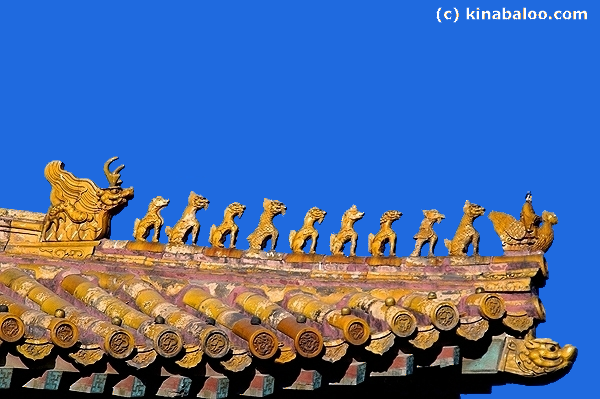
On the roof of the Hall of
Supreme Harmony, there is (starting from the front) :
在太和殿的屋顶的动物,是(从前面数):
an
immortal riding a phoenix, followed by: plus a LiWen at the end (螭吻) |
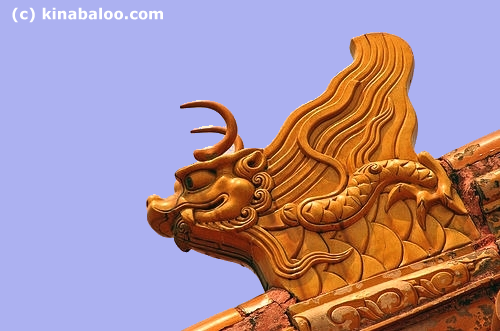 |
This is the fixed pattern
for the order of the animals.
这些动物的顺序是固定的模式。
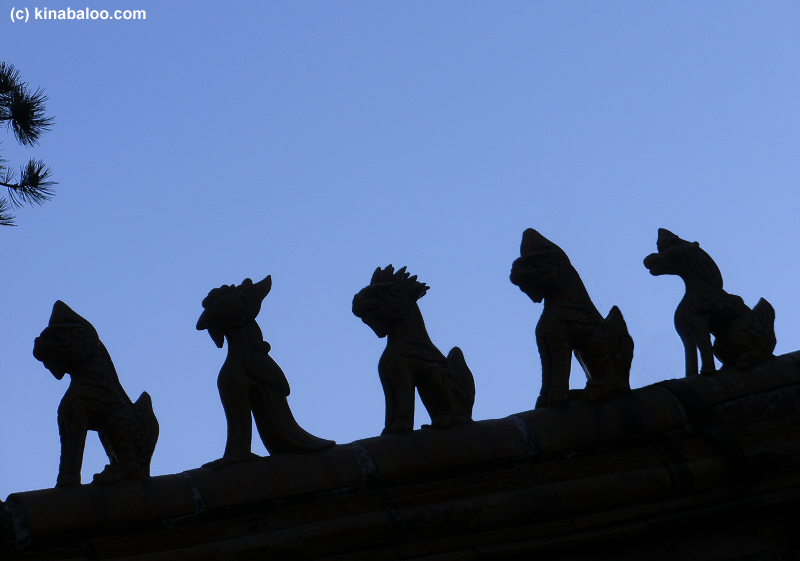
The Hall of Supreme Harmony was the throne hall, so it has the most animals on the roof. No other buildings in the country were allowed to have more. The other buildings in the Forbidden City are relatively less important and, therefore, the number of small animals on the roof is reduced. The elimination starts from the back.
太和殿是放金銮宝座的大殿,所以它的屋檐上的动物最多。在这个国家里没一个建筑比它多的了。在紫禁城里的一些其他建筑没它重要的建筑,屋檐上的小动物是依次递减的,不算螭吻,从后面开始。所以行什只出现这一回。
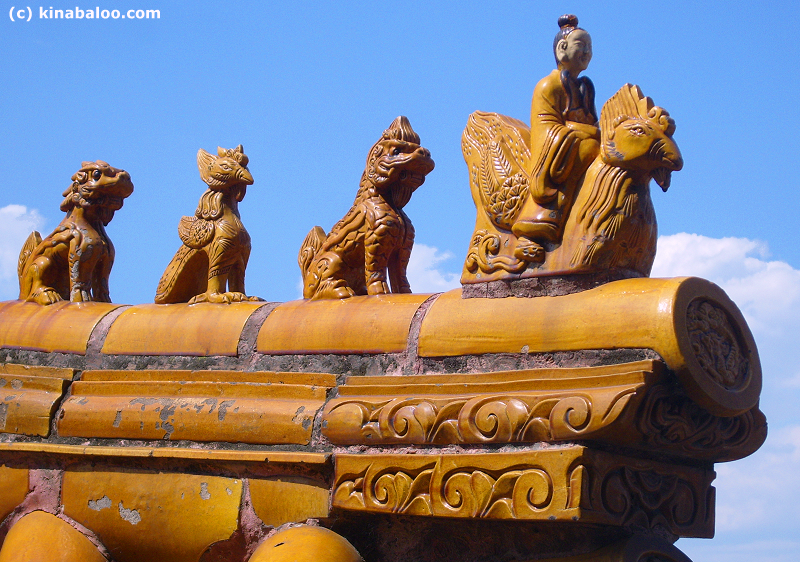
During the Han dynasty (206 BC - 220 AD), a characteristic layout for palace and temple buildings was developed that remained relatively constant through the centuries. Surrounded by an outer wall, the complex was arranged along a central axis that was approached by an entrance gate and then a spirit gate. Inside, first would be public space and lastly private space. Fuerthermore, residential units are arranged around a central courtyard. This layout was applied throughout the Forbidden City - as a wole and to particular areas.
The basic axial structure can be seen as a triplet - lead-in, central area, final area. In discussing the perfection of artistic works in his 'Study of Poetry', the ancient Greek philosopher Aristoteles said: "By perfection here I mean a thing with a beginning, middle and end." This sequence can be seen in all works of art, even if the boundaries are not explicit, or even well-defined. A good example is the classical music symphony with its prelude, climax and coda. The three parts are self-suffcient though with a temporal echoing such that the middle naturally builds upon the intro and suggests the finale while the whole has its own balance and integrity.
Originally, though less clear now, the Forbidden City is the second section of the old imperial city of Beijing - the middle of a larger triplet. The first part to the south, that is now TianAnMen Square, was originally a procession of three courtyards and grand gates. To the north of the Forbidden City, or 'Inner Imperial City', is now JingShan Park; this area includes the JingShan hill in the center, which serves as a protection from northerly winds and invaders, FengShui principles, and its wide profile, and height that is not so tall as to overpower the Forbidden City or too inconsequential, serves as a beautiful visual backdrop. Emperor QianLong added the five pavilions along the top of JingShan hill, suitable understated.
Behind JingShan Hill (so the third section of the third main section of the Imperial City axis) are the three halls: ShouHuangDian (Hall of Imperial Longevity) where portraits of ancestors were housed, YongSiDian (Hall of Everlasting Memory) and GuanDeDian (Hall of Morals Observation), which were used as mourning places for deceased emperors during the Qing Dynasty. Hence, this very last section of the Imperial City is effectively the most 'private' section. Beyond the three main sections of the south-north axis lie the Drum and Bell Towers.
The Forbidden City itself is composed of the three parts: QianChao (Outer Court), HouQin (Inner Court) and YuHuaYuan (Imperial Garden). The grand scale of the Imperial City, and the long lead-in, play up the sense of imperial authority. It takes time to pass through the grand courtyards and as one approaches each gate, it looms up and over one. This is especially true of the 'U shaped' WuMen gate which completely surrounds one as one gets within its two outstretched arms. All the courtyards before the Hall of Supreme Harmony (TaiHeDian) are without trees, which heightens the sense of space and seriousness.
The Inner Court is, in simple terms, a smaller echo of the Outer Court, though with differences.
The imperial garden is the third, last part of the Forbidden City, relatively small and with the feel of a private garden.
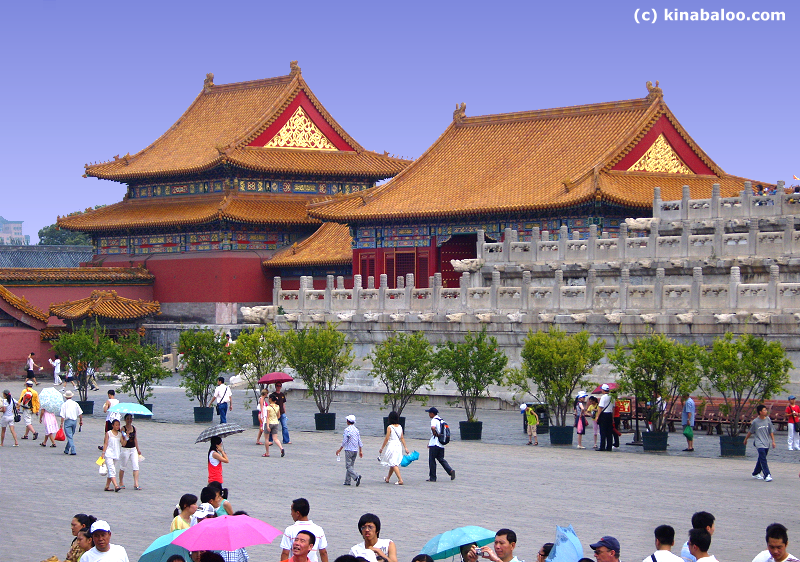
一份汉朝期间(公园前206-公园220年)典型的平面图被发现,它仍然保持相对恒定的,并且被运用到宫殿和寺庙的建筑上。四周被城墙环绕,所有的建筑物都沿着一条中轴线建造,由一个大门进入,然后是一个精神上的门,在它们之后依次是公共的大殿,最后是私人的住所,每一个住宅被围成一个封闭的庭院。这个基本模式适用于整个紫禁城。
紫禁城是北京就皇城的第二部分,从大清门开始(不存在了)起始点在正阳门的北边,穿过皇城宫城,一直到达北面的景山的最高点。整个轴长2500米长可以分为三个部分。就像交响乐的三个乐章——序曲、高潮、尾声。
首先是最长,从延伸的大清门到宫城前面的午门,在宫殿前由排成一排的广场组成,作为引领空间。第二部分高潮是故宫本身,前朝的三大殿、后勤和御花园。第三篇章是,从紫禁城北门的神武门延伸到景山的万春亭,景山的最高点。
所以,它有三个主要的篇章,每个篇章又分为三个小节。每一小节都不同,但他们又都相互联系和呼应。它们完成了一个宏伟的设计主题,创造一个美丽和谐的整体又渲染了皇帝的威武气魄。
在午门下的两个保卫房的尺寸好像是有意衬托这高耸的午门。午门左右两边向前延伸的部分,从而扩展了水平视角的风光和丰富了整体的格局。U字型的平面有着非常强烈的表达效果。作为游客当接近午门时,这巨大的建筑物和广阔的红城墙,似乎直接跃入你眼帘,给你一个不断强壮的压抑感和激烈感。
人们穿过这个漫长的广场,沿着小路走到它跟前好花很长一段时间,所以这种感觉会更变本加厉。总之,设计师们通过一系列技术创造了一个强大的震撼人心的气氛,来压制访客,创造皇帝的庄严神圣不可侵犯的感觉。
所有的广场从大清门到太和殿没有用花、草和树来铺设,起到了加强庄重、严肃气氛的效果。
在太和殿后是中和殿和保和殿,是用来衬托太和殿的。
这三个大殿座落在一个“土”字型的汉白玉的须弥座上。而按照阴阳五行原理要“敬土”,三大殿都做落在土上。太和殿又座落在前半部分“+”字交叉的地方正符合五行里,金、木、水、火、土,最值得尊敬的后者应端坐中间。
“后勤”部分采用卧式乾清门,引导的广场是一个长庭院。前面是最大的乾清宫,后面是稍小点的坤宁宫。一个方形的交泰殿被插在乾清宫和坤宁宫之间。这三个殿座落在一个两层高的“土”字型石基上,后朝的尺寸都要比前朝的小点,但是结构样式都是一样的,它似乎像交响乐的主旋律再现。
御花园是在后朝的最后,虽然把它称作花园但里面的建筑、小路、池塘、甚至栽种的花和树都是规则的对称的,只有一些局部变化,不同于那些自由的模式,即通常强调的中国园林。因为它是一个在有着严格模式和对称的皇城里,而且在南北中轴线上,所以局部要服从大局,以保持完整的风格。然而,古木名树,塔式的枝叶伸向天空,树荫遮地,这样一来,毕竟这里还是一个充满了随意享受美好生活的地方。
从御花园往北穿过一个小广场就可以找到,上面有塔楼的神武门。穿过北门,跨国护城河,在紫禁城的尽头就到了景山。景山是中间高两边低的,两边的东西都围绕着山。在山脊上有五个亭子,合适的作为这从紫禁城过来华丽中轴线的结束,显然,景山的尺寸不能太小,而建筑物的尺寸又不能太大,以避免抢了任何宫殿内部建筑的风头。为了解决这个,建筑师们建了大大的山,但在山顶建了相当小的五个亭子。景山作为整个富丽堂皇的紫禁城的背景,从而丰富了水平线上的视觉。
万春亭是景山中最大的一个亭子。它是方形的,三重卷檐,以黄色为主;在两边各有一个稍小点的八边型的,重檐结构,黄绿两色;最外面是两个最小的,圆形重檐,以绿色为主。富有节奏的变化,考虑到数量、形态、颜色、和大气的谐调,它得到更进一步的区分,庄严的殿堂与生动的皇家园林。
紫禁城是中国古代建筑艺术里,最好的最完整的一个古建筑群体实例。古希腊的哲学家亚里士多德在他的“诗学”中对这个完美的艺术作品的阐述是:“对于完美的我是这样认为的,一件事有它的开始、中间、结尾。在开始之前并不需要有任何的假设,但是应该有什么跟随着它。相反的,在结束之前必须确定这个假设在,要么必须要么可能,但你不必有任何东西跟随着它。在中间之前假设某些事情发生,某些事情会跟随。依照亚里士多德的观点,任何艺术品必须有它统一的原则,每一组的组成部分,又要有它自己的特点,然后构成一个统一的整体。
在一条轴线上设计分为不同的部分,在北京的宫殿都符合这个原则。但它的情形要远远比亚里士多德总结的复杂的多,它要求艺术家发挥更多细心和更多的精力去控制整个的情形。
紫禁城在世界上享有很高的声誉。英国的著名学者约瑟夫.尼达姆在他的著名著作《中国的科技与文明》中讨论关于紫禁城,他说:“我们发现了一连串彼此相连的独立空间......他们和欧洲文艺复兴时期的宫殿不一样。例如,凡尔赛视觉完全集中在一个单一的建筑上,而且宫殿和城市是分开的。相比之下,中国人的观念是非常深邃而复杂的, 因为有数以百计的结构在里面,而宫殿本身只是一个更大的整体。”
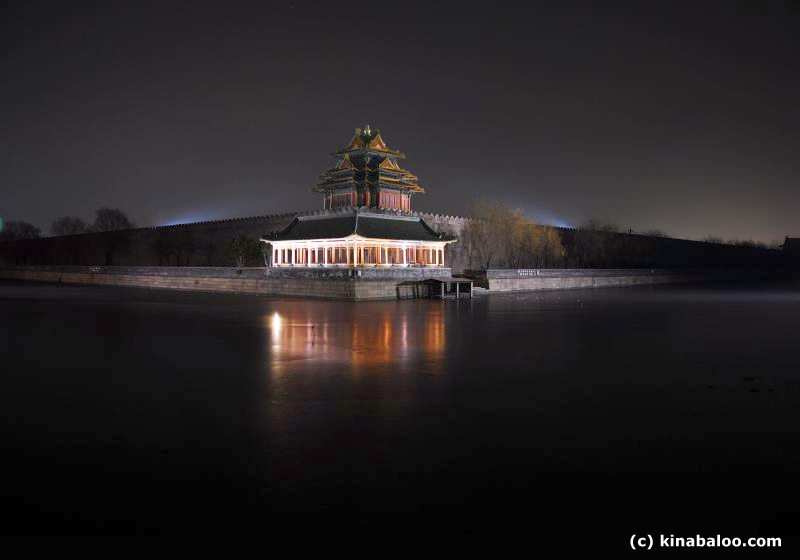
 Next : Getting to the
Forbidden City
Next : Getting to the
Forbidden City
 Forbidden City
Forbidden City
Home
 Forbidden City
Forbidden City
: Introduction
 Forbidden City : History
Forbidden City : History
 Forbidden City : Layout
Forbidden City : Layout
 Forbidden City : Map
Forbidden City : Map
 Getting there
Getting there

 The
Meridian Gate (outside)
The
Meridian Gate (outside)
 The
Meridian Gate (inside)
The
Meridian Gate (inside)
 The
First Courtyard
The
First Courtyard
 The
Gate of Supreme Harmony
The
Gate of Supreme Harmony
 The
Second Courtyard
The
Second Courtyard
 The
Hall of Supreme Harmony (part 1)
The
Hall of Supreme Harmony (part 1)
 The
Hall of Supreme Harmony (part 2)
The
Hall of Supreme Harmony (part 2)
 The
Hall of Complete Harmony
The
Hall of Complete Harmony
 The
Hall of Preserving Harmony
The
Hall of Preserving Harmony

 The
Gate of Celestial Purity
The
Gate of Celestial Purity
 The
Hall of Celestial Purity
The
Hall of Celestial Purity
 The
Hall of Celestial and Terrestrial Union
The
Hall of Celestial and Terrestrial Union
 The
Hall of Terrestrial Tranquility
The
Hall of Terrestrial Tranquility
 The
Imperial Garden
The
Imperial Garden
 The
Imperial Garden (part 2)
The
Imperial Garden (part 2)
 The
Exhibition Halls
The
Exhibition Halls
 The
9 Dragon Screen
The
9 Dragon Screen
 Other
Places of Interest
Other
Places of Interest

 Doorways
Doorways
 Doorways
(part 2)
Doorways
(part 2)
 Pots
Pots
 Sculptures
Sculptures
 Decorative
Tiles
Decorative
Tiles
 Roofs
Roofs
 Beams
and Ceilings
Beams
and Ceilings
 Windows
and Doors
Windows
and Doors
 Gorgoyles
Gorgoyles
 Ballustrades
Ballustrades
 Walls
& Screens
Walls
& Screens

Share this page

Quick Links
Top travel guides
 Great Wall Beijing
Great Wall Beijing
 YuanMingYuan
Park
YuanMingYuan
Park
China Travel and Culture Videos Home